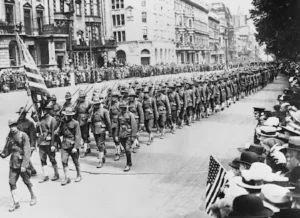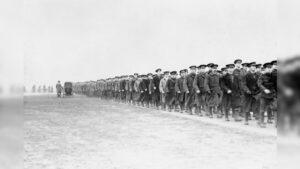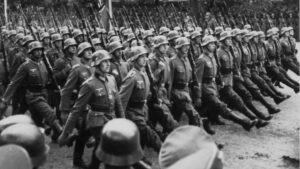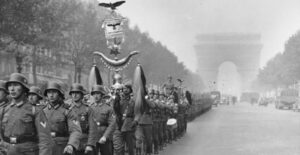Introduction
World War II, often referred to as WWII or the Second World War, was one of the most significant and devastating conflicts in human history. It lasted from 1939 to 1945 and involved the majority of the world’s nations. The war had profound and far-reaching consequences, reshaping the political, social, and economic landscape of the 20th century.
The roots of World War II can be traced back to several complex factors, including unresolved issues from World War I, the rise of aggressive dictatorships, economic instability, and the failure of international diplomacy. In this essay, we will delve into the key events, causes, and consequences of the war that would change the world.
Major Causes of World War II
Its origins can be traced back to various factors that built up over decades. Here are some of the major causes of World War II:
1. Treaty of Versailles:
The Treaty of Versailles, which formally ended World War I in 1919, played a significant role in setting the stage for World War II. It imposed harsh penalties and territorial losses on Germany, leading to economic hardship, national humiliation, and resentment among the German population. This provided fertile ground for the rise of Adolf Hitler and the Nazi Party.
2. Economic Factors:
The Great Depression of the 1930s exacerbated economic hardships worldwide. High unemployment, inflation, and economic instability created fertile ground for extremist political movements to gain power. In Germany, this led to the Nazi Party’s rise, promising economic recovery and national rejuvenation.
3. Expansionism and Imperialism:
Several nations, including Japan, Italy, and Germany, pursued aggressive expansionist policies. Japan sought to establish a Greater East Asia Co-Prosperity Sphere, Italy aimed to expand its territory in North Africa, and Germany sought to overturn the territorial restrictions imposed by the Treaty of Versailles.
4. Appeasement:
Western democracies, particularly Britain and France, followed a policy of appeasement towards the aggressive actions of Nazi Germany in the 1930s. They hoped that by making concessions and avoiding conflict, they could prevent another world war. However, this policy only emboldened Hitler and allowed him to carry out further expansionist actions.
5. Militarization and Rearmament:
Germany, in violation of the Treaty of Versailles, rapidly rearmament, expanding its military and industrial capabilities. This militarization raised alarm among its neighbors and contributed to a growing arms race, as other nations also began to strengthen their armed forces.

6. Invasion of Poland (1939):
The immediate trigger for the outbreak of World War II was the invasion of Poland by Germany on September 1, 1939. This act of aggression violated numerous international agreements and led Britain and France to declare war on Germany on September 3, 1939, marking the official start of World War II.
7. Alliance Systems:
The formation of military alliances, particularly the Axis Powers (Germany, Italy, and Japan) and the Allies (including the United States, Britain, and the Soviet Union), further escalated the conflict. The alliances provided mutual support and deterrence, making the war a global conflict.
8. Nazi Ideology and Aggression:
The aggressive expansionism and extreme ideology of Nazi Germany played a central role in the outbreak of World War II. Hitler’s belief in Aryan supremacy, Lebensraum (living space), and the desire for territorial conquest drove German expansionist policies.
9. Soviet-German Non-Aggression Pact (Molotov-Ribbentrop Pact):
In 1939, Nazi Germany and the Soviet Union signed a non-aggression pact, allowing them to divide Eastern Europe into spheres of influence. This pact not only enabled the invasion of Poland but also ensured that the Soviet Union would not interfere when Germany subsequently invaded Western Europe.
10. Globalization of the Conflict:
World War II expanded beyond Europe into Asia, Africa, and the Pacific. Japan’s expansionist policies in Asia, including the invasion of China and the attack on Pearl Harbor in 1941, drew the United States into the war, transforming it into a truly global conflict.
Major Effect of Second World War
1. Political Effects
a. Formation of the United Nations:
The war led to the establishment of the United Nations (UN) in 1945, aimed at promoting international cooperation and preventing future conflicts through diplomacy and dialogue.
b. Decolonization:
The war weakened European colonial powers, and the post-war period saw a wave of decolonization as colonies in Asia and Africa gained independence.
c. Emergence of Superpowers:
The United States and the Soviet Union emerged as superpowers, leading to the Cold War and the division of the world into two ideological blocs.

2. Economic Effects
a. Reconstruction and Economic Boom:
Post-war reconstruction efforts spurred economic growth, particularly in Western Europe and Japan. The war also led to technological innovations, including the development of nuclear power and the computer.
b. Creation of the Bretton Woods System:
The Bretton Woods Conference in 1944 established a new international monetary system, including the creation of the International Monetary Fund (IMF) and the World Bank, to stabilize global finances.
3. Social Effects
a. Casualties and Displacement:
The war resulted in the death of millions of people and the displacement of millions more. This led to significant social disruptions and refugee crises.
b. Civil Rights Movements:
The war exposed the hypocrisy of racial discrimination in the United States and elsewhere, contributing to the Civil Rights Movement and the push for equality.
c. Women’s Liberation:
Women played crucial roles on the home front and in the workforce during the war, leading to the advancement of women’s rights and the feminist movement.
4. Technological Effects
a. Nuclear Age:
The use of atomic bombs on Hiroshima and Nagasaki in 1945 marked the beginning of the nuclear age, leading to the arms race and the development of nuclear deterrence strategies.
b. Space Exploration:
The war’s technological advancements paved the way for the space age, with both the United States and the Soviet Union launching space programs.
5. Cultural Effects
a. Holocaust and Memory:
The Holocaust, in which millions of Jews and others were systematically murdered, had a profound impact on global consciousness and led to efforts to preserve its memory.
b. Literature and Film:
The war inspired countless works of literature and film, including iconic pieces such as “Schindler’s List” and “The Diary of Anne Frank.”
6. Geopolitical Effects
a. Cold War:
The division of the world into Eastern and Western blocs led to the Cold War, a period of intense ideological rivalry and proxy conflicts.
b. Formation of NATO and Warsaw Pact:
Military alliances, such as NATO and the Warsaw Pact, were established to safeguard the interests of the superpowers and their allies.

Countries in World War II
A large number of countries and territories were involved in this war. The war had a profound global impact, reshaping the political, social and economic landscape of the world. Learn in detail about the countries that were involved in World War II, highlighting their roles, alliances and contributions in this monumental event
The Allies
United States of America:
The United States entered the war on December 7, 1941, following the Japanese attack on Pearl Harbor. It played a pivotal role in the conflict, providing both military and economic support to the Allies. The U.S. was a major supplier of arms, equipment, and troops. The American industrial complex shifted into high gear, producing weapons, ships, and aircraft on an unprecedented scale. The U.S. also played a crucial role in the Pacific theater, leading to the defeat of Japan with the dropping of atomic bombs on Hiroshima and Nagasaki in August 1945.
United Kingdom:
The United Kingdom was one of the first countries to declare war on Germany in 1939 after the invasion of Poland. Throughout the war, Britain stood as a symbol of resistance against Nazi aggression, with Winston Churchill as its inspirational leader. British forces, along with those from the British Commonwealth, played key roles in the European and North African theaters. The Battle of Britain in 1940 was a critical turning point, as the Royal Air Force successfully defended the country against German bombing raids.
Soviet Union:
The Soviet Union, led by Joseph Stalin, signed a non-aggression pact with Nazi Germany in 1939, known as the Molotov-Ribbentrop Pact. However, this alliance was short-lived, as Germany invaded the Soviet Union in June 1941 in Operation Barbarossa. The Soviet Union then became a vital Allied power on the Eastern Front. The brutal fighting on this front was a significant factor in the defeat of Nazi Germany. The Battle of Stalingrad, in particular, was a turning point that marked the beginning of the Soviet advance toward Berlin.
France:
France was one of the first countries to be invaded by Nazi Germany in 1940. The German occupation of France was a dark period, but the French Resistance emerged to sabotage German efforts and gather intelligence. After D-Day in 1944, Allied forces liberated France, and the country played a role in the liberation of Western Europe.
China:
China had been fighting against Japanese aggression since the early 1930s. It was already at war with Japan when World War II officially began in 1939. China’s resistance played a crucial role in tying down Japanese forces in Asia and the Pacific. The Chinese theater of the war is often referred to as the Second Sino-Japanese War.
Canada, Australia, New Zealand, and other Commonwealth nations:
These countries, as part of the British Commonwealth, played significant roles in World War II. Canadian forces were particularly prominent in Europe, while Australian and New Zealand troops fought in the Pacific and other theaters.
Poland, Belgium, the Netherlands, and Norway:
These countries were among the first to be invaded by Nazi Germany in 1939 and 1940. While they initially faced occupation, they contributed to the Allied cause through governments-in-exile and resistance movements.

Greece and Yugoslavia:
Both countries were invaded by Axis powers during the war. Greek forces held off the Italian invasion in 1940, and Yugoslavia resisted the German advance in 1941. These countries later played roles in the liberation of their territories.
Brazil:
Brazil declared war on the Axis powers in 1942 and contributed troops to the Allied effort in Europe. Its Navy also played a role in patrolling the South Atlantic.
Other European Nations:
Various European countries, including Norway, Denmark, Belgium, and the Netherlands, were occupied by Nazi Germany but contributed to the Allied effort through resistance movements and governments-in-exile.
India and Africa:
The British Empire’s colonial subjects in India and Africa made significant contributions to the war effort. Indian troops fought in various theaters, and African colonies provided resources and manpower.
Gibraltar:
The British Overseas Territory of Gibraltar played a vital role as a naval and air base for the Allies, controlling access to the Mediterranean.
The Axis Powers
Germany:
Led by Adolf Hitler, Nazi Germany was the primary aggressor in World War II. Its expansionist ambitions, invasion of Poland in 1939, and subsequent invasions of other European countries triggered the conflict.
Japan:
Japan had been expanding its empire in Asia since the 1930s. The invasion of China, the Marco Polo Bridge Incident in 1937, and the attack on Pearl Harbor in 1941 brought Japan into the global conflict. Japanese forces occupied significant parts of Southeast Asia and the Pacific.
Italy:
Under the leadership of Benito Mussolini, Italy joined the war on the side of Germany in 1940. Italian forces were involved in campaigns in North Africa, the Balkans, and the Eastern Front.
Hungary, Romania, Bulgaria, and Finland:
These countries aligned themselves with Nazi Germany at various points during the war, either as a result of alliances or territorial ambitions.
Neutral Countries
Several countries managed to remain neutral during World War II, despite the widespread conflict. Switzerland, Sweden, Spain, and Portugal were among the most prominent neutral nations. Their neutrality allowed them to avoid the destruction and devastation experienced by countries directly involved in the conflict.

Casualties in World War II
World War II, which took place from 1939 to 1945, resulted in a staggering number of casualties. Here are some key figures:
Military Casualties:
Allied Powers (including the United States, United Kingdom, Soviet Union etc.): Approximately 16 million military personnel.
Axis Powers (including Germany, Japan, Italy etc.): Approximately 8 million military personnel.
Civilian Casualties:
Civilian casualties were tragically high during World War II, primarily due to bombings, starvation, and other wartime hardships.
It is estimated that between 45 and 50 million civilians lost their lives during the war.
Holocaust:
The Holocaust, perpetrated by Nazi Germany, resulted in the systematic genocide of approximately 6 million Jews in addition to millions of others, including Romani people, disabled individuals, political dissidents, and more.
Total Casualties:
The total number of casualties, including both military and civilian, is estimated to be over 70 million people.
These numbers represent the immense human cost of World War II, making it one of the deadliest conflicts in human history. The war had far-reaching political, social, and economic consequences, leading to significant changes in the world order.
Key Facts about Volcanic Eruptions – Effects and Causes
Conclusion
Second World War in 1945 marked a pivotal moment in global history, bringing an end to six years of devastating conflict that engulfed the world. There were two primary theaters of war: the European and Pacific theaters.
In Europe, the war ended on May 8, 1945, with the unconditional surrender of Nazi Germany. This momentous occasion was celebrated as Victory in Europe Day. The defeat of Nazi Germany was achieved through a combination of Allied efforts, including the D-Day invasion of Normandy, the Eastern Front battles, and the strategic bombing campaign.
In the Pacific, the war concluded a few months later, after the United States dropped atomic bombs on the Japanese cities of Hiroshima and Nagasaki in August 1945. The devastation caused by these bombings prompted Japan to surrender on August 15, 1945. This day is remembered as Victory over Japan Day, and the formal surrender ceremony took place on September 2, 1945, aboard the USS Missouri in Tokyo Bay.
The aftermath of World War II saw the establishment of the United Nations, the Nuremberg Trials to hold Nazi leaders accountable for war crimes, and the beginning of the Cold War between the United States and the Soviet Union. The war’s conclusion reshaped the geopolitical landscape and set the stage for the post-war era.




















[…] World War II: Causes, Casualties and History […]
I loved you even more than you’ll say here. The picture is nice and your writing is stylish, but you read it quickly. I think you should give it another chance soon. I’ll likely do that again and again if you keep this walk safe.
Nice blog here Also your site loads up fast What host are you using Can I get your affiliate link to your host I wish my web site loaded up as quickly as yours lol
It was great seeing how much work you put into it. Even though the design is nice and the writing is stylish, you seem to be having trouble with it. I think you should really try sending the next article. I’ll definitely be back for more of the same if you protect this hike.
Wow wonderful blog layout How long have you been blogging for you make blogging look easy The overall look of your site is great as well as the content
helloI really like your writing so a lot share we keep up a correspondence extra approximately your post on AOL I need an expert in this house to unravel my problem May be that is you Taking a look ahead to see you
Somebody essentially help to make significantly articles Id state This is the first time I frequented your web page and up to now I surprised with the research you made to make this actual post incredible Fantastic job
Just wish to say your article is as surprising The clearness in your post is just cool and i could assume youre an expert on this subject Fine with your permission allow me to grab your RSS feed to keep updated with forthcoming post Thanks a million and please keep up the enjoyable work
Hi Neat post There is a problem along with your website in internet explorer would test this IE still is the market chief and a good section of other folks will pass over your magnificent writing due to this problem
My brother suggested I might like this blog He was totally right This post actually made my day You can not imagine simply how much time I had spent for this info Thanks
Its like you read my mind You appear to know so much about this like you wrote the book in it or something I think that you can do with a few pics to drive the message home a little bit but instead of that this is excellent blog A fantastic read Ill certainly be back
Hi my loved one I wish to say that this post is amazing nice written and include approximately all vital infos Id like to peer more posts like this
I’ve been following your blog for quite some time now, and I’m continually impressed by the quality of your content. Your ability to blend information with entertainment is truly commendable.
Your point of view caught my eye and was very interesting. Thanks. I have a question for you.
Your article helped me a lot, is there any more related content? Thanks!
Usually I do not read article on blogs however I would like to say that this writeup very compelled me to take a look at and do it Your writing style has been amazed me Thank you very nice article
you are in reality a just right webmaster The site loading velocity is incredible It seems that you are doing any unique trick In addition The contents are masterwork you have performed a wonderful task on this topic
Thank you for your sharing. I am worried that I lack creative ideas. It is your article that makes me full of hope. Thank you. But, I have a question, can you help me?